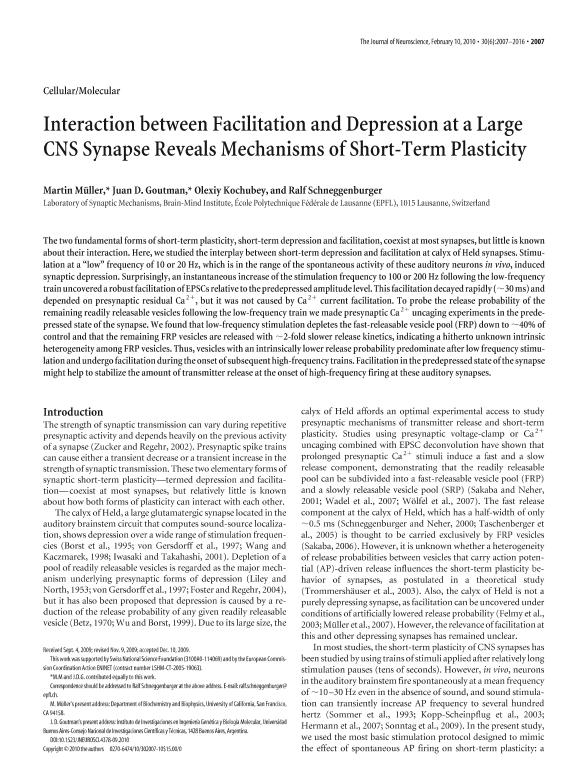Mostrar el registro sencillo del ítem
dc.contributor.author
Müller, Martin
dc.contributor.author
Goutman, Juan Diego

dc.contributor.author
Kochubey, Olexiy
dc.contributor.author
Schneggenburger, Ralf
dc.date.available
2018-08-02T20:12:41Z
dc.date.issued
2010-02
dc.identifier.citation
Müller, Martin; Goutman, Juan Diego; Kochubey, Olexiy; Schneggenburger, Ralf; Interaction between facilitation and depression at a large CNS synapse reveals mechanisms of short-term plasticity; Society for Neuroscience; Journal of Neuroscience; 30; 6; 2-2010; 2007-2016
dc.identifier.issn
0270-6474
dc.identifier.uri
http://hdl.handle.net/11336/53968
dc.description.abstract
The two fundamental forms of short-term plasticity, short-term depression and facilitation, coexist at most synapses, but little is known about their interaction. Here, we studied the interplay between short-term depression and facilitation at calyx of Held synapses. Stimulation at a "low" frequency of 10 or 20 Hz, which is in the range of the spontaneous activity of these auditory neurons in vivo, induced synaptic depression. Surprisingly, an instantaneous increase of the stimulation frequency to 100 or 200 Hz following the low-frequency train uncovered a robust facilitation of EPSCs relative to the predepressed amplitude level. This facilitation decayed rapidly (∼30 ms) and depended on presynaptic residual Ca2+, but it was not caused by Ca2+ current facilitation. To probe the release probability of the remaining readily releasable vesicles following the low-frequency train we made presynaptic Ca2+ uncaging experiments in the predepressed state of the synapse. We found that low-frequency stimulation depletes the fast-releasable vesicle pool (FRP) down to ∼40% of control and that the remaining FRP vesicles are released with ∼2-fold slower release kinetics, indicating a hitherto unknown intrinsic heterogeneity among FRP vesicles. Thus, vesicles with an intrinsically lower release probability predominate after low frequency stimulation and undergo facilitation during the onset of subsequent high-frequency trains. Facilitation in the predepressed state of the synapse might help to stabilize the amount of transmitter release at the onset of high-frequency firing at these auditory synapses.
dc.format
application/pdf
dc.language.iso
eng
dc.publisher
Society for Neuroscience

dc.rights
info:eu-repo/semantics/openAccess
dc.rights.uri
https://creativecommons.org/licenses/by-nc-sa/2.5/ar/
dc.subject
Synaptic Transmission
dc.subject
Facilitation
dc.subject
Depression
dc.subject
Exocytosis
dc.subject.classification
Neurociencias

dc.subject.classification
Medicina Básica

dc.subject.classification
CIENCIAS MÉDICAS Y DE LA SALUD

dc.title
Interaction between facilitation and depression at a large CNS synapse reveals mechanisms of short-term plasticity
dc.type
info:eu-repo/semantics/article
dc.type
info:ar-repo/semantics/artículo
dc.type
info:eu-repo/semantics/publishedVersion
dc.date.updated
2018-07-30T15:39:39Z
dc.journal.volume
30
dc.journal.number
6
dc.journal.pagination
2007-2016
dc.journal.pais
Estados Unidos

dc.description.fil
Fil: Müller, Martin. Ecole Polytechnique Federale de Lausanne; Suiza
dc.description.fil
Fil: Goutman, Juan Diego. Ecole Polytechnique Federale de Lausanne; Suiza. Consejo Nacional de Investigaciones Científicas y Técnicas; Argentina
dc.description.fil
Fil: Kochubey, Olexiy. Ecole Polytechnique Federale de Lausanne; Suiza
dc.description.fil
Fil: Schneggenburger, Ralf. Ecole Polytechnique Federale de Lausanne; Suiza
dc.journal.title
Journal of Neuroscience

dc.relation.alternativeid
info:eu-repo/semantics/altIdentifier/doi/http://dx.doi.org/10.1523/JNEUROSCI.4378-09.2010
dc.relation.alternativeid
info:eu-repo/semantics/altIdentifier/url/http://www.jneurosci.org/content/30/6/2007
Archivos asociados
